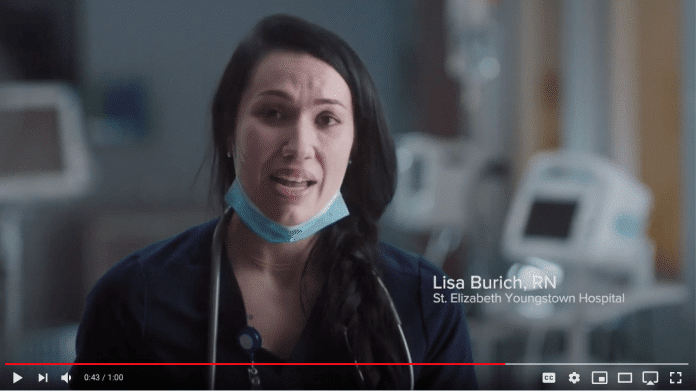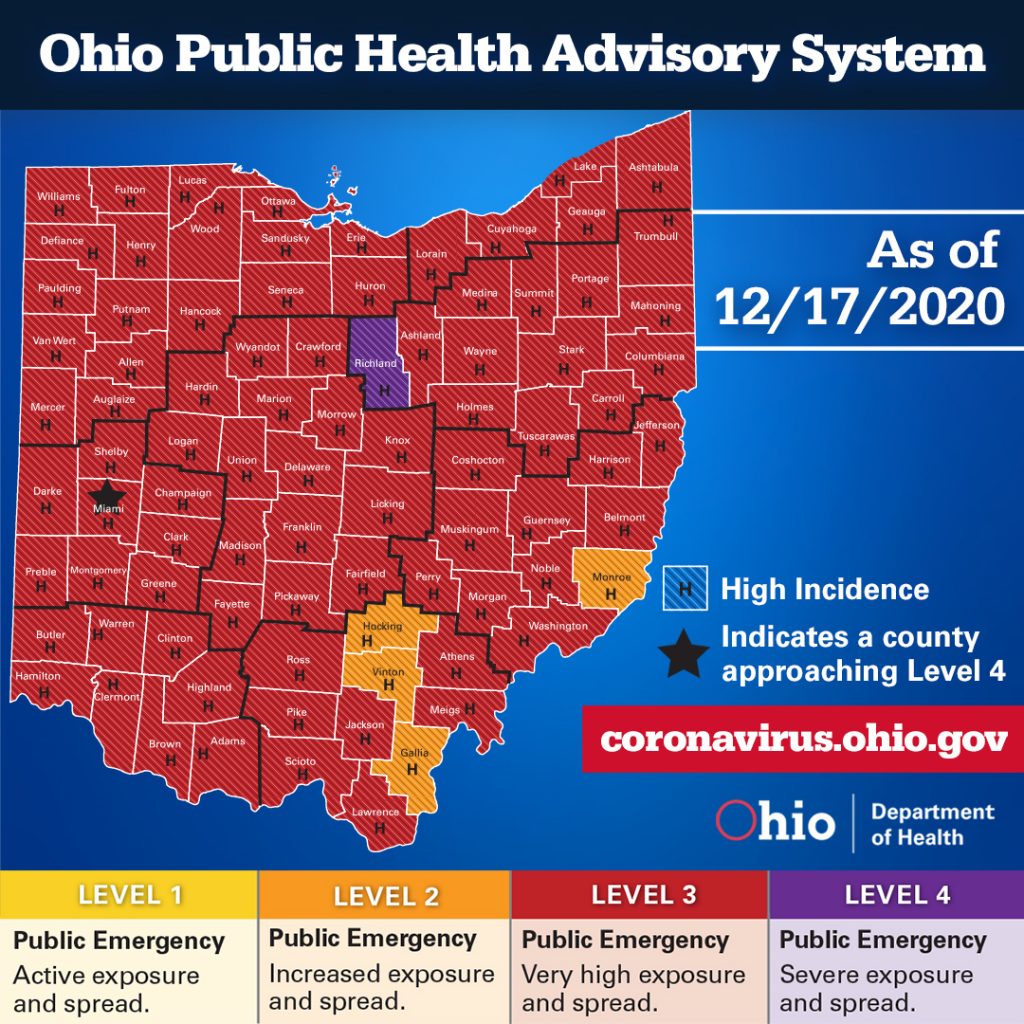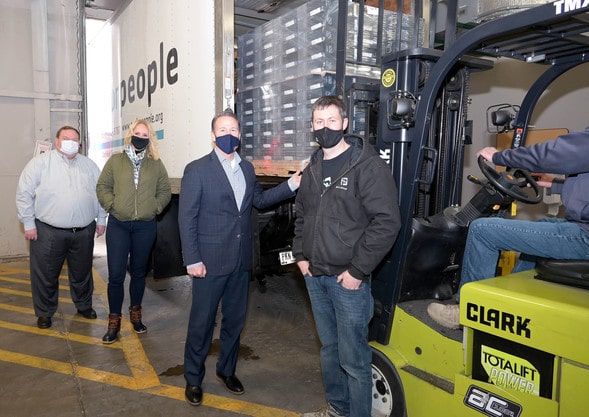
Ohio launches tracking dashboard for COVID-19 vaccines | The dashboard will list the number of people vaccinated in Ohio and will be sortable by demographic and county.
Throughout the week, Ohio Gov. Mike DeWine was joined by Lt. Gov. Jon Husted, and provided updates on Ohio’s response to the COVID-19 pandemic, as well as other state initiatives.
The week in review
• On Monday, DeWine announced that the first COVID-19 vaccinations have been administered in Ohio. Shipments of 975 doses were delivered to both The Ohio State University Wexner Medical Center in Columbus and UC Health in Cincinnati. Several healthcare workers and personnel who are routinely involved with the care of COVID-19 patients immediately received vaccinations.
“It was such a moment of hope to watch the healthcare workers begin to get vaccinated,” said DeWine. “This is the first day of a process that will continue over the months ahead as Ohioans who choose to be vaccinated have their opportunity to receive the vaccine. However, until the vaccine is widely available for all Ohioans who choose to receive it, we must continue to use all available tools to prevent the spread of the virus, like wearing a mask, keeping your distance, and washing your hands.”
As COVID-19 vaccines continue to come to Ohio, Cardinal Health’s OptiFreight Logistics business will provide same-day delivery services. Once the vaccine is widely available, the partnership will allow Ohio to ship the vaccine to approximately 350 locations across the state.
• The Centers for Disease Control and Prevention invited Ohio to participate in an early scaled launch of vaccinations in nursing homes, beginning Friday. (Ohio had previously been scheduled to start its nursing home vaccination program in partnership with pharmacy providers on Monday, Dec. 21.)
• DeWine announced that Ohio will launch a new COVID-19 Vaccination Dashboard at coronavirus.ohio.gov…. It will list the number of people vaccinated in Ohio and will be sortable by demographic and county.
• On Tuesday, seven hospitals in Ohio received their first vaccine shipments, bringing the total number of vaccine doses delivered to Ohio to 98,475.
• Gov. DeWine and first lady Fran DeWine were present for the delivery of the vaccine shipment to Mercy Health Springfield Regional Medical Center. Lt. Gov. Husted visited OhioHealth Riverside Methodist Hospital in Columbus as they received their first delivery of COVID-19 vaccines.
A number of healthcare workers who received vaccinations joined DeWine on a public briefing to discuss their experiences, including registered nurse Kasi Gardner of Mercy Health Springfield Regional Medical Center, who received her vaccine during the news conference.
Dr. Jennifer Wall Forrester, associate chief medical officer at UC Health, also discussed when citizens should call their doctors or go to the hospital if they develop COVID-19 symptoms. See YouTube video for more information.
Hospitalizations
Ohioans continue to be hospitalized in record numbers. As of Tuesday, 5,296 patients are hospitalized throughout the state and 1,311 of those patients are in intensive-care units. Ohio currently has more patients in the ICU than it had total for all COVID-19 hospitalized patients during the previous peak last summer. There are currently 863 patients who need a ventilator as of Tuesday, as compared to 360 patients on ventilators a month ago.
“While there is good reason to be optimistic about Ohioans receiving the vaccine, we have our work cut out for us to slow the spread of the virus until enough Ohioans can be vaccinated,” said DeWine. “We must continue rallying together to prevent overwhelming our hospitals.”
Local health department vaccination guidance
Next week, local health departments in Ohio that registered as providers are expected to begin receiving vaccines. DeWine outlined guidance on individuals who should be prioritized by health departments during Phase 1A.
Priorities/guidance: Local health departments should coordinate the vaccinations of congregate-care residents and staff, such as those at nursing homes and assisted-living facilities, who are not enrolled in the federal long-term care pharmacy programs or are not registered as providers themselves. This includes people with developmental disabilities and those with mental-health disorders, including substance-use disorders, who live in group homes, residential facilities, or centers, as well as staff. In addition, local health departments should prioritize vaccinating other healthcare providers who are not being vaccinated by hospitals and health systems and are not enrolled as providers themselves. These providers could include:
- home health workers;
- hospice workers;
- emergency medical services responders;
- primary care practitioners;
- free-standing emergency department, urgent care, pharmacy, and dialysis center providers not vaccinated by hospitals or healthcare systems;
- dental providers;
- public health employees who are at risk of exposure or transmission, such as vaccinators;
- mobile unit practitioners;
- federally-qualified health center providers;
- high-risk ancillary health care staff members.
Pilot project for high speed internet access
On Wednesday, Husted announced that Allen Township, outside of Marysville, will be the site of a pilot project, with the Starlink satellite-broadband service developed by SpaceX, to connect select households and small businesses with high speed internet access. The pilot is part of the DeWine-Husted Administration’s commitment to bringing high speed internet access to Ohioans across the state.
The pilot will test the delivery of Starlink’s space-based high speed internet to 90 households and about 10 small businesses. All of the participants are underserved by broadband. It marks the largest Starlink pilot in the Midwest and it was facilitated through the partnership of InnovateOhio, BroadbandOhio, the City of Marysville, economic leaders in Union County, and JobsOhio, the state’s private nonprofit economic development corporation.
“This past year has shown that now more than ever, access to high-speed internet is an essential element for participating in the modern economy, education and healthcare systems,” said Husted. “Too many Ohioans have unreliable broadband, or no connection at all, and Governor DeWine and I are committed to finding solutions to this challenge.”
The pilot is expected to begin in the first quarter of 2021 and the service will run at no cost to the participants for 12 months.
New data shows sustained severe exposure/spread for COVID-19
On Thursday, new health data compiled by the Ohio Department of Health showed sustained severe exposure and spread (Purple Level 4) in Richland County. Medina, Portage, Stark, and Summit counties all moved from Purple Level 4 to Red Level 3 this week. DeWine cautioned that a decrease from Level 4 to Level 3 does not indicate that the situation in these counties is improving, but rather that healthcare indicators, such as hospitalizations, are plateauing at a very critical level.
“Red and purple are not all that different,” said DeWine. “They both mean that a county has a very high level of cases and a very high level of COVID-19 activity in the healthcare system. Purple simply indicates counties where things are worsening noticeably, but red counties are also at very worrisome and unsustainable levels.”

A county-by-county breakdown outlining the presence of COVID-19 in all of Ohio’s 88 counties can be found on the Ohio Public Health Advisory System’s website. All 88 counties have a level of spread that is at least three times more than what the Centers for Disease Control and Prevention (CDC) considers high incidence. The top 20 counties show rates of nine to 13 times the high-incidence level. See COVID-19 cases by Zip Code.
Vaccine update
On Friday, as part of the federal program to vaccinate nursing home residents and staff, facilities in Ohio will be among the first in the nation to receive vaccines through Walgreen’s, CVS, PharmScript, and Absolute Pharmacy. Ohio was invited by the CDC to participate in the scaling up of the federal program.
New PSA featuring Ohio frontline nurses
DeWine unveiled a new public service announcement featuring four of Ohio’s frontline nurses. The nurses describe what it’s like taking care of COVID-19 patients in Ohio’s hospitals. The featured nurses are Erin Russo of Memorial Hospital in Marysville, Dara Pence of OhioHealth Riverside Methodist Hospital, Jasmine Shavers of Miami Valley Hospital, and Lisa Burich of St. Elizabeth Youngstown Hospital.
Grants to combat drug crisis
• Also on Thursday, DeWine joined Sen. Rob Portman, Recovery Ohio Director Alisha Nelson, and Ohio Department of Mental Health and Addiction Services (OhioMHAS) Director Lori Criss to announce grants totaling $76,534,000 for new strategic efforts combatting Ohio’s drug crisis in local communities.
The grants, which represent a portion of Ohio’s overall share of $96 million in federal State Opioid Response (SOR) 2.0 funding, come at a time when many communities are seeing a spike in demand for behavioral health services amid the ongoing coronavirus pandemic. OhioMHAS will grant $58,884,000 directly to local county alcohol, drug addiction and mental health services boards and their community partners. Additional funding for innovations in approaches to connecting people to care will be made available by OhioMHAS as part the SOR 2.0 investments.
“Many communities are seeing an increase in demand for mental health and substance use disorder services as the pandemic continues. The uncertainties of the pandemic intensify the struggle with substance use disorder that many Ohioans face,” said DeWine.
For more on what Ohio is doing to fight opioid addiction, visit recoveryohio.gov…. Click here to view a one-page overview of Ohio’s SOR 2.0 project and here for background on Ohio’s State Opioid Response efforts to date.

• Also on Thursday, Husted along with Matt Damschroder, director of the Ohio Department of Administrative Services, and Lydia Mihalik, director of the Ohio Development Services Agency, announced that Ohio is donating a surplus of 148 computers to PCs for People to help more Ohioans afford and obtain an internet-enabled device that is suitable for working and learning.
The donation is another BroadbandOhio project that expands the administration’s efforts to expand and enhance broadband connectivity for businesses and families in Ohio.
“Internet access is critical. It enables individuals to search for a job, complete schoolwork, access health care and more, all remotely,” Husted said. “Just as important is the availability of internet-enabled devices, and businesses across Ohio can help give access to those who need it simply by donating their surplus devices.”
The donated devices will be repurposed and distributed to eligible, low-income families across Ohio who are in need of an affordable internet-enabled device.
PCs for People is a national non-profit organization, with a local Cleveland chapter, that wipes all data, refurbishes, and then distributes digital devices to low-income households. For more information, visit PCsforPeople.org….
Eliminating Racial Disparities in Infant Mortality Task Force
Also on Thursday, DeWine announced that he is establishing the Eliminating Racial Disparities in Infant Mortality Task Force. Members will work with local, state, and national leaders to identify needed changes to address Ohio’s racial disparities in infant mortality. With the goal of developing a statewide shared vision and strategy for reducing infant mortality rates and eliminating racial disparities by 2030, the Task Force will create actionable recommendations for interventions, performance and quality improvement, data collection, and policies to advise the Governor’s Office of Children’s Initiatives on improving Ohio’s investments and strategies in addressing racial inequities in birth outcomes.
The task force will begin its work in January 2021 and will include listening sessions in each of the nine counties designated as Ohio Equity Institute (OEI) counties, as well as in Allen and Lorain counties. These 11 counties represent geographies with high numbers of Black births and infant deaths.
• On Friday, the DeWines and Husted visited nursing facilities across the state to watch the administration of the first COVID-19 vaccines in the nation in long-term care facilities as part of a new partnership. The vaccines, which were given to residents and staff who chose to receive them, were given as part of the early scaling up of the federal Pharmacy Long-Term Care Partnership program.
• As of Friday, there have been 605,862 confirmed and probable cases of COVID-19 in Ohio and 7,967 confirmed and probable COVID-19 deaths. A total of 34,143 people have been hospitalized, including 5,429 admissions to intensive care units. In-depth data can be accessed by visiting coronavirus.ohio.gov….
For more information on Ohio’s response to COVID-19, visit coronavirus.ohio.gov… or call 1-833-4-ASK-ODH.
NEWS & FEATURES – Find news and features for Youngstown, Ohio, and the greater Mahoning Valley. Includes feature articles, news briefs, interviews, Letters to the Editor, columnists, and special topics (education, local history, seasonal guides, community development, and community changes).
Metro Monthly is a local news and events magazine based in Youngstown, Ohio. Stay connected with news, features and essential Valley events. We circulate throughout the Mahoning Valley (and beyond) with print, online and flipbook editions. We offer print and website advertising. Office: 330-259-0435.
© 2020 Metro Monthly. All rights reserved.




